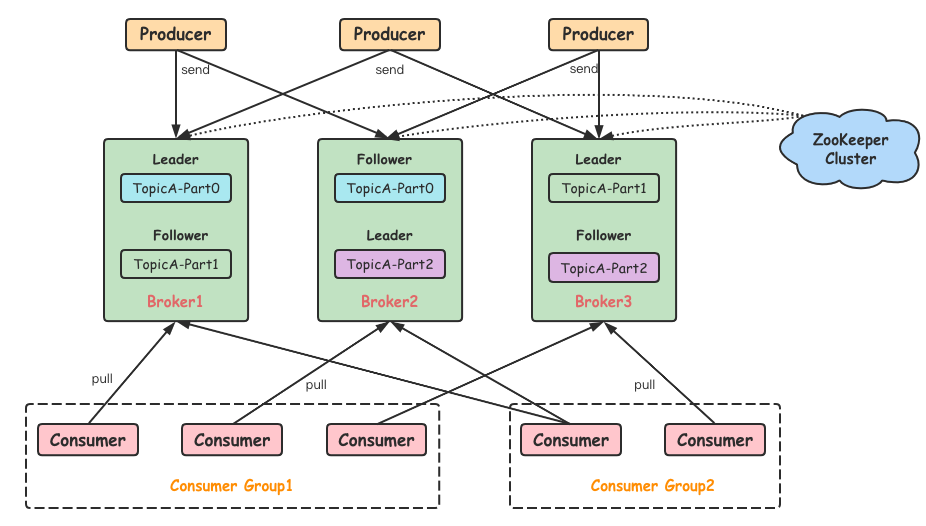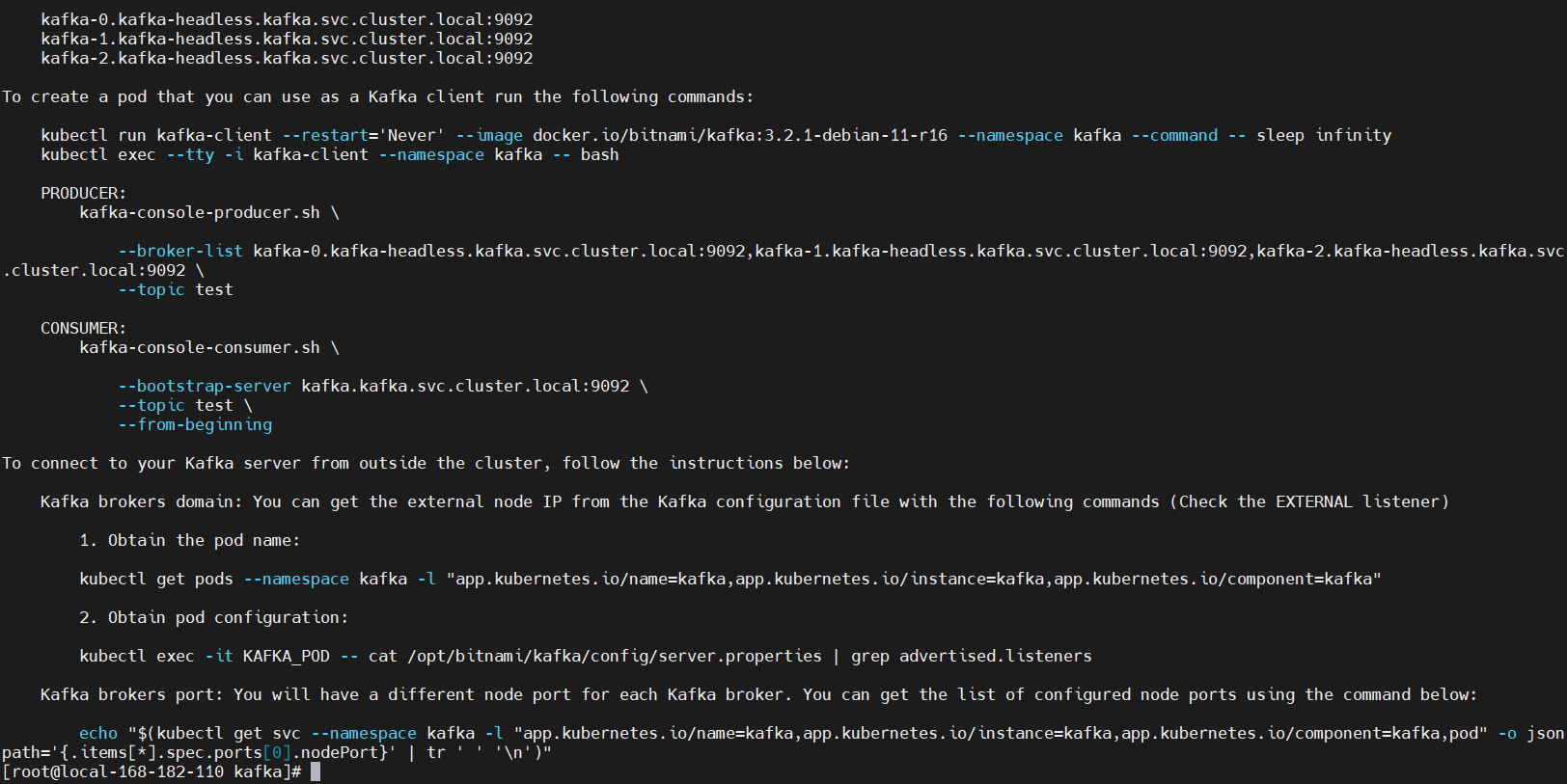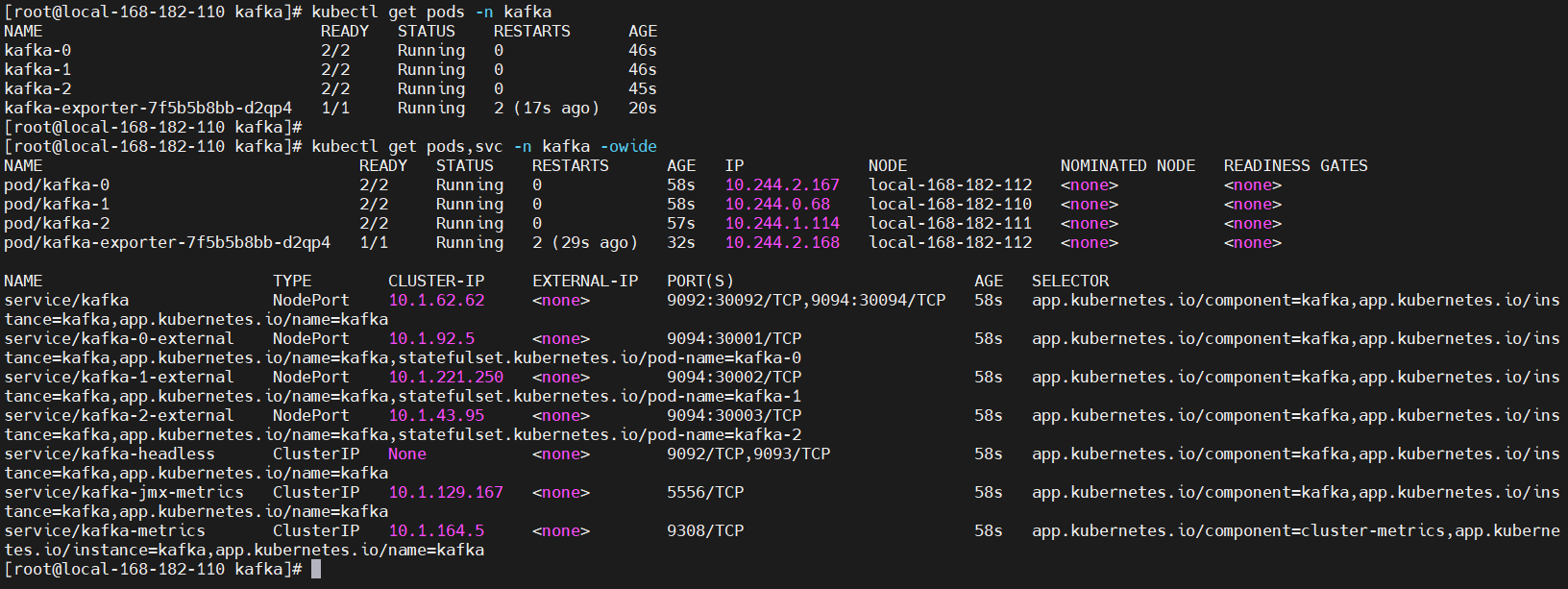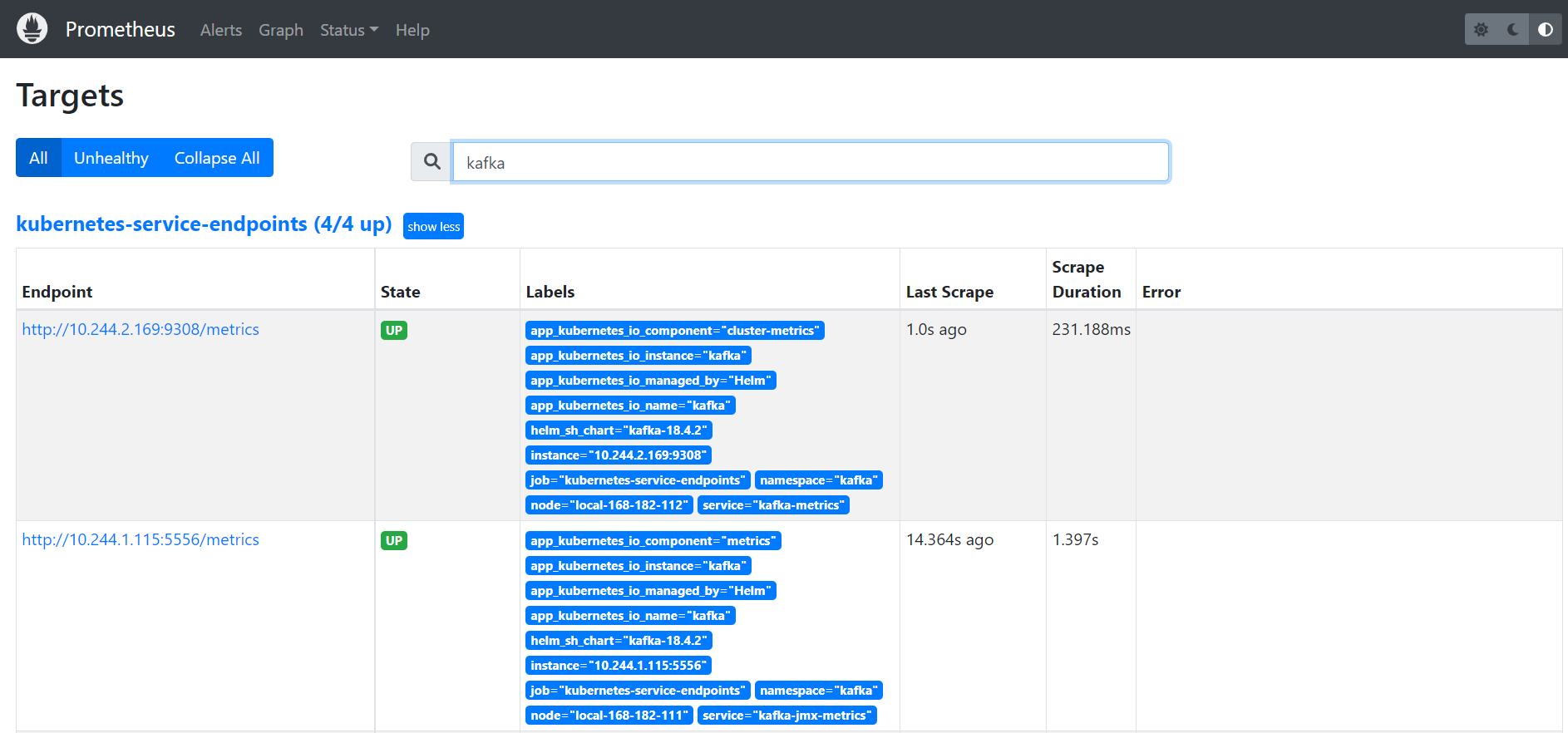-
【云原生】zookeeper + kafka on k8s 环境部署
一、概述
Apache ZooKeeper是一个集中式服务,用于维护配置信息、命名、提供分布式同步和提供组服务,ZooKeeper 致力于开发和维护一个开源服务器,以实现高度可靠的分布式协调,其实也可以认为就是一个分布式数据库,只是结构比较特殊,是树状结构。官网文档:https://zookeeper.apache.org/doc/r3.8.0/
,关于Zookeeper的介绍,也可以参考我之前的文章:分布式开源协调服务——Zookeeper

Kafka是最初由Linkedin公司开发,是一个分布式、支持分区的(partition)、多副本的(replica),基于zookeeper协调的分布式消息系统。官方文档:https://kafka.apache.org/documentation/关于Kafka的介绍,也可以参考我之前的文章:Kafka原理介绍+安装+基本操作

二、Zookeeper on k8s 部署

1)添加源
部署包地址:https://artifacthub.io/packages/helm/zookeeper/zookeeper
helm repo add bitnami https://charts.bitnami.com/bitnami helm pull bitnami/zookeeper tar -xf zookeeper-10.2.1.tgz2)修改配置
- 修改
zookeeper/values.yaml
image: registry: myharbor.com repository: bigdata/zookeeper tag: 3.8.0-debian-11-r36 ... replicaCount: 3 ... service: type: NodePort nodePorts: #NodePort 默认范围是 30000-32767 client: "32181" tls: "32182" ... persistence: storageClass: "zookeeper-local-storage" size: "10Gi" # 目录需要提前在宿主机上创建 local: - name: zookeeper-0 host: "local-168-182-110" path: "/opt/bigdata/servers/zookeeper/data/data1" - name: zookeeper-1 host: "local-168-182-111" path: "/opt/bigdata/servers/zookeeper/data/data1" - name: zookeeper-2 host: "local-168-182-112" path: "/opt/bigdata/servers/zookeeper/data/data1" ... # Enable Prometheus to access ZooKeeper metrics endpoint metrics: enabled: true- 添加
zookeeper/templates/pv.yaml
{{- range .Values.persistence.local }} --- apiVersion: v1 kind: PersistentVolume metadata: name: {{ .name }} labels: name: {{ .name }} spec: storageClassName: {{ $.Values.persistence.storageClass }} capacity: storage: {{ $.Values.persistence.size }} accessModes: - ReadWriteOnce local: path: {{ .path }} nodeAffinity: required: nodeSelectorTerms: - matchExpressions: - key: kubernetes.io/hostname operator: In values: - {{ .host }} --- {{- end }}- 添加
zookeeper/templates/storage-class.yaml
kind: StorageClass apiVersion: storage.k8s.io/v1 metadata: name: {{ .Values.persistence.storageClass }} provisioner: kubernetes.io/no-provisioner3)开始安装
# 先准备好镜像 docker pull docker.io/bitnami/zookeeper:3.8.0-debian-11-r36 docker tag docker.io/bitnami/zookeeper:3.8.0-debian-11-r36 myharbor.com/bigdata/zookeeper:3.8.0-debian-11-r36 docker push myharbor.com/bigdata/zookeeper:3.8.0-debian-11-r36 # 开始安装 helm install zookeeper ./zookeeper -n zookeeper --create-namespaceNOTES
NAME: zookeeper LAST DEPLOYED: Sun Sep 18 18:24:03 2022 NAMESPACE: zookeeper STATUS: deployed REVISION: 1 TEST SUITE: None NOTES: CHART NAME: zookeeper CHART VERSION: 10.2.1 APP VERSION: 3.8.0 ** Please be patient while the chart is being deployed ** ZooKeeper can be accessed via port 2181 on the following DNS name from within your cluster: zookeeper.zookeeper.svc.cluster.local To connect to your ZooKeeper server run the following commands: export POD_NAME=$(kubectl get pods --namespace zookeeper -l "app.kubernetes.io/name=zookeeper,app.kubernetes.io/instance=zookeeper,app.kubernetes.io/component=zookeeper" -o jsonpath="{.items[0].metadata.name}") kubectl exec -it $POD_NAME -- zkCli.sh To connect to your ZooKeeper server from outside the cluster execute the following commands: export NODE_IP=$(kubectl get nodes --namespace zookeeper -o jsonpath="{.items[0].status.addresses[0].address}") export NODE_PORT=$(kubectl get --namespace zookeeper -o jsonpath="{.spec.ports[0].nodePort}" services zookeeper) zkCli.sh $NODE_IP:$NODE_PORT
查看pod状态kubectl get pods,svc -n zookeeper -owide
4)测试验证
# 登录zookeeper pod kubectl exec -it zookeeper-0 -n zookeeper -- zkServer.sh status kubectl exec -it zookeeper-1 -n zookeeper -- zkServer.sh status kubectl exec -it zookeeper-2 -n zookeeper -- zkServer.sh status kubectl exec -it zookeeper-0 -n zookeeper -- bash
5)Prometheus监控
Prometheus:https://prometheus.k8s.local/targets?search=zookeeper

可以通过命令查看采集数据
kubectl get --raw http://10.244.0.52:9141/metrics kubectl get --raw http://10.244.1.101:9141/metrics kubectl get --raw http://10.244.2.137:9141/metricsGrafana:https://grafana.k8s.local/
账号:admin,密码通过下面命令获取kubectl get secret --namespace grafana grafana -o jsonpath="{.data.admin-password}" | base64 --decode ; echo导入grafana模板,集群资源监控:
10465
官方模块下载地址:https://grafana.com/grafana/dashboards/

6)卸载
helm uninstall zookeeper -n zookeeper kubectl delete pod -n zookeeper `kubectl get pod -n zookeeper|awk 'NR>1{print $1}'` --force kubectl patch ns zookeeper -p '{"metadata":{"finalizers":null}}' kubectl delete ns zookeeper --force三、Kafka on k8s 部署
1)添加源
部署包地址:https://artifacthub.io/packages/helm/bitnami/kafka
helm repo add bitnami https://charts.bitnami.com/bitnami helm pull bitnami/kafka tar -xf kafka-18.4.2.tgz2)修改配置
- 修改
kafka/values.yaml
image: registry: myharbor.com repository: bigdata/kafka tag: 3.2.1-debian-11-r16 ... replicaCount: 3 ... service: type: NodePort nodePorts: client: "30092" external: "30094" ... externalAccess enabled: true service: type: NodePort nodePorts: - 30001 - 30002 - 30003 useHostIPs: true ... persistence: storageClass: "kafka-local-storage" size: "10Gi" # 目录需要提前在宿主机上创建 local: - name: kafka-0 host: "local-168-182-110" path: "/opt/bigdata/servers/kafka/data/data1" - name: kafka-1 host: "local-168-182-111" path: "/opt/bigdata/servers/kafka/data/data1" - name: kafka-2 host: "local-168-182-112" path: "/opt/bigdata/servers/kafka/data/data1" ... metrics: kafka: enabled: true image: registry: myharbor.com repository: bigdata/kafka-exporter tag: 1.6.0-debian-11-r8 jmx: enabled: true image: registry: myharbor.com repository: bigdata/jmx-exporter tag: 0.17.1-debian-11-r1 annotations: prometheus.io/path: "/metrics" ... zookeeper: enabled: false ... externalZookeeper servers: - zookeeper-0.zookeeper-headless.zookeeper - zookeeper-1.zookeeper-headless.zookeeper - zookeeper-2.zookeeper-headless.zookeeper- 添加
kafka/templates/pv.yaml
{{- range .Values.persistence.local }} --- apiVersion: v1 kind: PersistentVolume metadata: name: {{ .name }} labels: name: {{ .name }} spec: storageClassName: {{ $.Values.persistence.storageClass }} capacity: storage: {{ $.Values.persistence.size }} accessModes: - ReadWriteOnce local: path: {{ .path }} nodeAffinity: required: nodeSelectorTerms: - matchExpressions: - key: kubernetes.io/hostname operator: In values: - {{ .host }} --- {{- end }}- 添加
kafka/templates/storage-class.yaml
kind: StorageClass apiVersion: storage.k8s.io/v1 metadata: name: {{ .Values.persistence.storageClass }} provisioner: kubernetes.io/no-provisioner3)开始安装
# 先准备好镜像 docker pull docker.io/bitnami/kafka:3.2.1-debian-11-r16 docker tag docker.io/bitnami/kafka:3.2.1-debian-11-r16 myharbor.com/bigdata/kafka:3.2.1-debian-11-r16 docker push myharbor.com/bigdata/kafka:3.2.1-debian-11-r16 # node-export docker pull docker.io/bitnami/kafka-exporter:1.6.0-debian-11-r8 docker tag docker.io/bitnami/kafka-exporter:1.6.0-debian-11-r8 myharbor.com/bigdata/kafka-exporter:1.6.0-debian-11-r8 docker push myharbor.com/bigdata/kafka-exporter:1.6.0-debian-11-r8 # JXM docker.io/bitnami/jmx-exporter:0.17.1-debian-11-r1 docker tag docker.io/bitnami/jmx-exporter:0.17.1-debian-11-r1 myharbor.com/bigdata/jmx-exporter:0.17.1-debian-11-r1 docker push myharbor.com/bigdata/jmx-exporter:0.17.1-debian-11-r1 #开始安装 helm install kafka ./kafka -n kafka --create-namespaceNOTES
NAME: kafka LAST DEPLOYED: Sun Sep 18 20:57:02 2022 NAMESPACE: kafka STATUS: deployed REVISION: 1 TEST SUITE: None NOTES: CHART NAME: kafka CHART VERSION: 18.4.2 APP VERSION: 3.2.1 --------------------------------------------------------------------------------------------- WARNING By specifying "serviceType=LoadBalancer" and not configuring the authentication you have most likely exposed the Kafka service externally without any authentication mechanism. For security reasons, we strongly suggest that you switch to "ClusterIP" or "NodePort". As alternative, you can also configure the Kafka authentication. --------------------------------------------------------------------------------------------- ** Please be patient while the chart is being deployed ** Kafka can be accessed by consumers via port 9092 on the following DNS name from within your cluster: kafka.kafka.svc.cluster.local Each Kafka broker can be accessed by producers via port 9092 on the following DNS name(s) from within your cluster: kafka-0.kafka-headless.kafka.svc.cluster.local:9092 kafka-1.kafka-headless.kafka.svc.cluster.local:9092 kafka-2.kafka-headless.kafka.svc.cluster.local:9092 To create a pod that you can use as a Kafka client run the following commands: kubectl run kafka-client --restart='Never' --image docker.io/bitnami/kafka:3.2.1-debian-11-r16 --namespace kafka --command -- sleep infinity kubectl exec --tty -i kafka-client --namespace kafka -- bash PRODUCER: kafka-console-producer.sh \ --broker-list kafka-0.kafka-headless.kafka.svc.cluster.local:9092,kafka-1.kafka-headless.kafka.svc.cluster.local:9092,kafka-2.kafka-headless.kafka.svc.cluster.local:9092 \ --topic test CONSUMER: kafka-console-consumer.sh \ --bootstrap-server kafka.kafka.svc.cluster.local:9092 \ --topic test \ --from-beginning To connect to your Kafka server from outside the cluster, follow the instructions below: Kafka brokers domain: You can get the external node IP from the Kafka configuration file with the following commands (Check the EXTERNAL listener) 1. Obtain the pod name: kubectl get pods --namespace kafka -l "app.kubernetes.io/name=kafka,app.kubernetes.io/instance=kafka,app.kubernetes.io/component=kafka" 2. Obtain pod configuration: kubectl exec -it KAFKA_POD -- cat /opt/bitnami/kafka/config/server.properties | grep advertised.listeners Kafka brokers port: You will have a different node port for each Kafka broker. You can get the list of configured node ports using the command below: echo "$(kubectl get svc --namespace kafka -l "app.kubernetes.io/name=kafka,app.kubernetes.io/instance=kafka,app.kubernetes.io/component=kafka,pod" -o jsonpath='{.items[*].spec.ports[0].nodePort}' | tr ' ' '\n')"
查看pod状态kubectl get pods,svc -n kafka -owide
4)测试验证
# 登录zookeeper pod kubectl exec -it kafka-0 -n kafka -- bash1、创建Topic(一个副本一个分区)
--create: 指定创建topic动作 --topic:指定新建topic的名称 --bootstrap-server: 指定kafka连接地址 --config:指定当前topic上有效的参数值,参数列表参考文档为: Topic-level configuration --partitions:指定当前创建的kafka分区数量,默认为1个 --replication-factor:指定每个分区的复制因子个数,默认1个kafka-topics.sh --create --topic test001 --bootstrap-server kafka.kafka:9092 --partitions 1 --replication-factor 1 # 查看 kafka-topics.sh --describe --bootstrap-server kafka.kafka:9092 --topic test001
2、查看Topic列表
kafka-topics.sh --list --bootstrap-server kafka.kafka:90923、生产者/消费者测试
【生产者】
kafka-console-producer.sh --broker-list kafka.kafka:9092 --topic test001 {"id":"1","name":"n1","age":"20"} {"id":"2","name":"n2","age":"21"} {"id":"3","name":"n3","age":"22"}【消费者】
# 从头开始消费 kafka-console-consumer.sh --bootstrap-server kafka.kafka:9092 --topic test001 --from-beginning # 指定从分区的某个位置开始消费,这里只指定了一个分区,可以多写几行或者遍历对应的所有分区 kafka-console-consumer.sh --bootstrap-server kafka.kafka:9092 --topic test001 --partition 0 --offset 100 --group test0014、查看数据积压
kafka-consumer-groups.sh --bootstrap-server kafka.kafka:9092 --describe --group test0015、删除topic
kafka-topics.sh --delete --topic test001 --bootstrap-server kafka.kafka:90925)Prometheus监控
Prometheus:https://prometheus.k8s.local/targets?search=kafka

可以通过命令查看采集数据
kubectl get --raw http://10.244.2.165:9308/metricsGrafana:https://grafana.k8s.local/
账号:admin,密码通过下面命令获取kubectl get secret --namespace grafana grafana -o jsonpath="{.data.admin-password}" | base64 --decode ; echo导入grafana模板,集群资源监控:
11962
官方模块下载地址:https://grafana.com/grafana/dashboards/6)卸载
helm uninstall kafka -n kafka kubectl delete pod -n kafka `kubectl get pod -n kafka|awk 'NR>1{print $1}'` --force kubectl patch ns kafka -p '{"metadata":{"finalizers":null}}' kubectl delete ns kafka --forcezookeeper + kafka on k8s 环境部署 就先到这里了,小伙伴有任何疑问,欢迎给我留言,后续会持续分享【云原生和大数据】相关的问题~
-
相关阅读:
【博学谷学习记录】超强总结,用心分享丨大数据从0到1落地(一):Scala基础语法
java基于springboot+vue公司员工工资考勤管理系统
YbtOJ「基础算法」第1章 递推算法
如何实现一个sync.Once
搞定了!OAuth2使用验证码进行授权
C++(二)
Redis最新2023年面试题高级面试题及附答案解析(2)【Redis最新2023年面试题高级面试题及附答案解析-第三十九刊】
基于PSO粒子群优化的汽车刹车稳定性数据matlab仿真与分析
如何高性能、高效率地实现3D Web轻量化?
MMKV(2)
- 原文地址:https://blog.csdn.net/qq_35745940/article/details/126919918